One of my very favorite series of texts dealing with original sources that illuminate the NT is the series now published by Eerdmans entitled New Documents Illustrating Early Christianity. It is a series originating out of the ancient history department at Macquarrie University in Sydney Aus. and is loaded with all sorts of inscriptions, many of them unpublished before now that helps us understand the linguistic and social context of the NT. Below is a helpful review of Vol. 10 of this series which came out in 2012 (and they are all very valuable). The review is by my friend Larry Hurtado originally found on his blog. He is offering a helpful representative sample. BW3
———-
by larryhurtado
Over on the blog-site for our Centre for the Study of Christian Origins, I’ve just posted about the latest volume in the New Documents Illustrating Early Christianity series (vol. 10, Eerdmans, 2012), underscoring the value of the series for scholars in NT/Christian origins for grasping more of the historical context of earliest Christianity: here. Illustrative of the fund of valuable discussion, I’ll mention here just one of the entries in this latest volume.
Item #3 in the volume (pp. 10-15) discusses an inscription on a cameo gem dated ca. 25-50 CE in which powerful names are invoked for protective purposes (Iao, Adonai, Abrasax). The discussion ranges wider, however, the author of the piece (J. R. Harrison) drawing in a helpful set of other primary data and a rich bibliography of other scholarly studies to focus on apotropaic/magical practices such as reflected in this cameo inscription.
These include the use of powerful names, and the notion that by naming spirit/divine beings one could compel them to do the seeker’s will. Harrison comments cogently on the relevance of this for various NT passages/scenes in which, e.g., demonic beings seek to coerce Jesus (Mark 1:24; 3:11; 5:7), magicians seek to employ Jesus’ name similarly (Acts 19:13), and the sense of the Greek word “ἐπικαλέω” (“call upon”) as a typical term connoting the invocation of a deity or powerful spirit.
As Harrison notes, it is also interesting that the Gospels portray Jesus as not using these techniques in his own exorcisms and healings. Instead, he is pictured as simply commanding the demons or ordering the healing. This must mean that the Gospel writers sought to differentiate Jesus’ actions from the widely-known exorcistic/magical practices of the time. And, of course, it is therefore historically plausible that this reflects Jesus’ own actual practice, exercising a distinctive sense of personal empowerment that differentiated him sharply in the ancient historical context.
There are 29 entries in volume 10 of the New Documents series, each of which amply repays reading it. Anyone doing serious study of the NT texts cannot ignore this valuable series.














